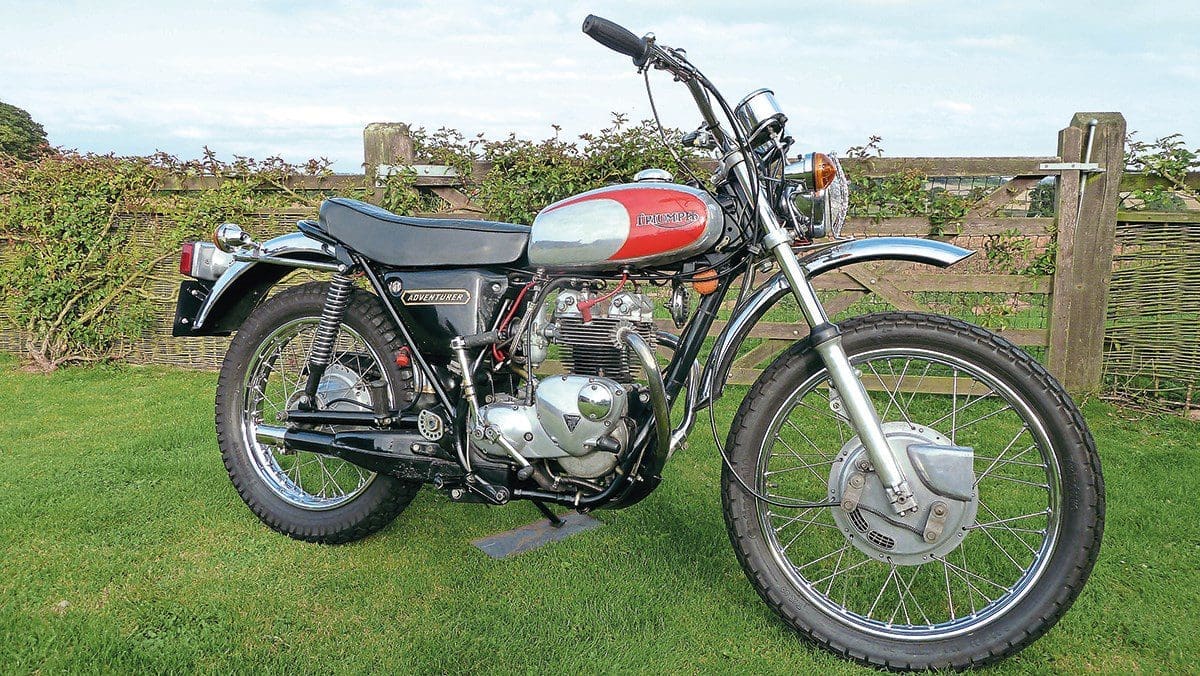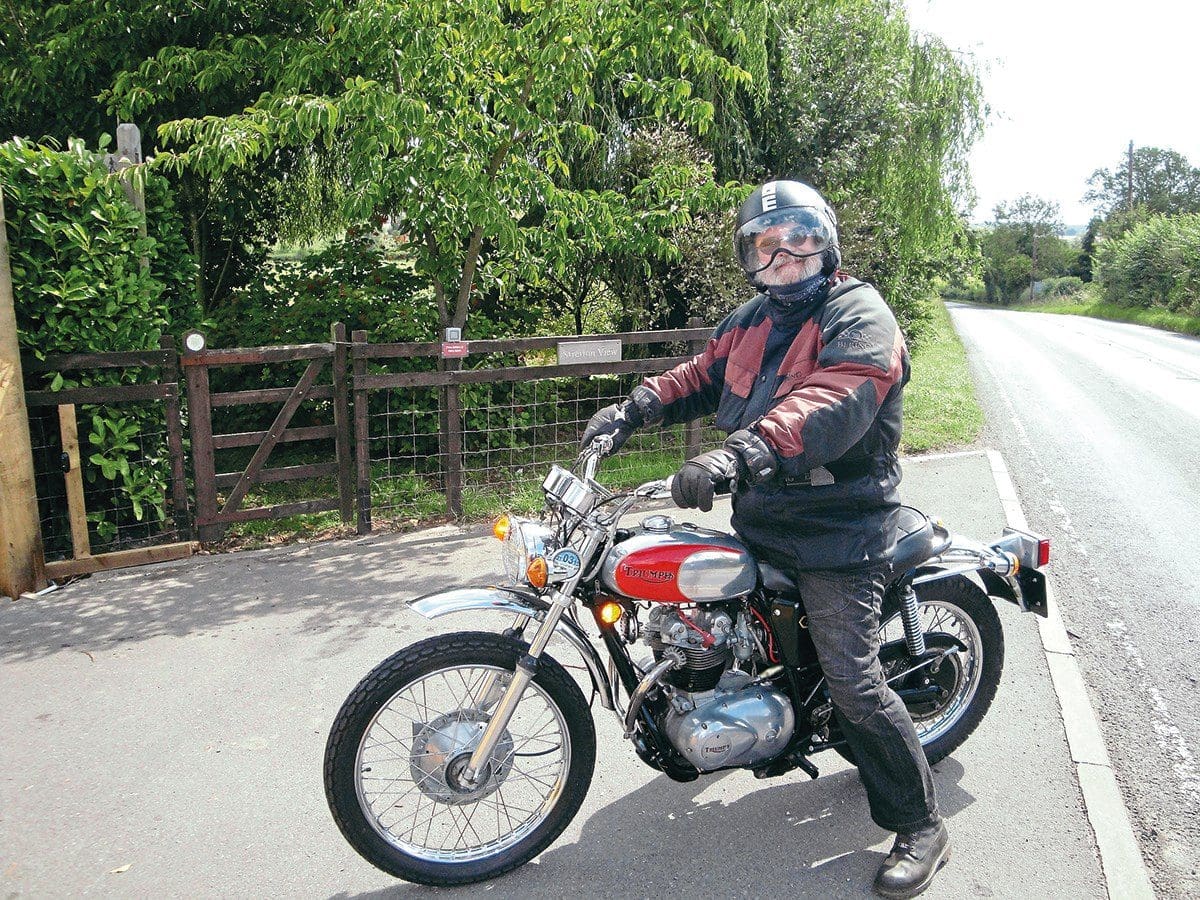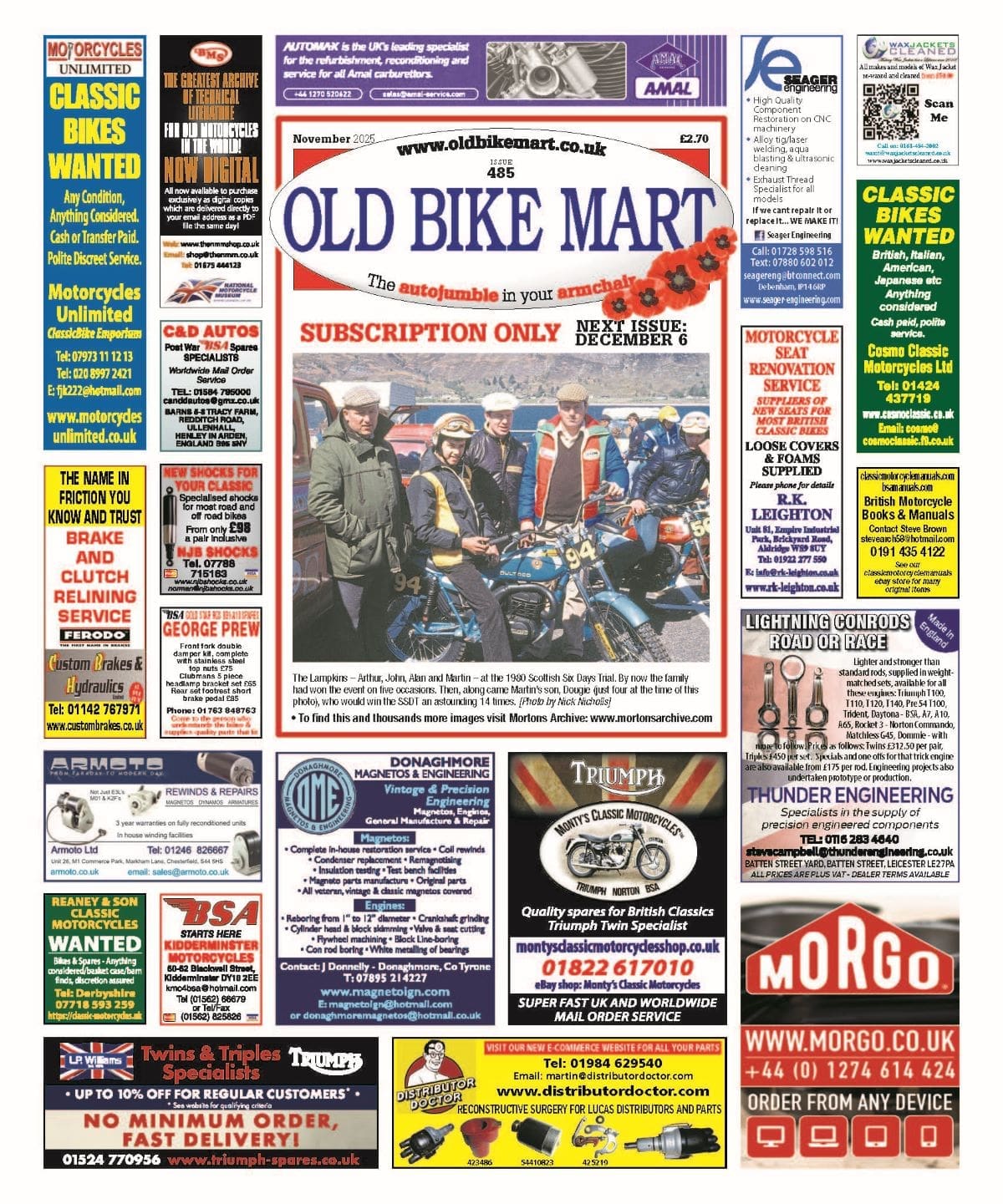Continuing with his hybrid theme, Frank Westworth, the founder of Classic Bike Guide, looks at the one that got away – Triumph’s TR5T
Words by Frank with photos from Mortons Archive

Enjoy more classic motorcycle reading, Click here to subscribe to one of our leading magazines.
Back in those apparently glorious youthful days when we were all masters or mistresses of the universe, also impossibly vigorous, good-looking and quite possibly kind to animals, there was a great two-wheeled obsession with building specials. I even tried this myself, and several of my more spannery buddies built a few that were almost acceptable riding machines. Unlike my own attempts. About which I will never darken your lightness, because some things are simply too awful to see the light of day.
In case you’d either forgotten 1960s specials – or are in the happy position of being far too young to have experienced them – I will offer a few general thoughts. These are personal, based entirely on the genuine life experiences (or whatever we’re supposed to call them) of someone who passed his bike test in 1970, aged either 16 or 17, whichever was legal at the time.
Although the classic myth has it that specials were built to combine the very best bits from all manner of machinery in order to excel at competition, grim reality in my part of rural Somerset was that specials were built to combine mysterious confections of bits from crashed bikes (the source of engines) or blown-up bikes (the source of frames and such like). Sad, as we say, but true.
And there were some very special specials. Few of your actual Tritons thereabouts (apart from one built by a pal who stuck a postwar 6T engine into a plunger Norton bicycle, causing adolescent terror among all who rode it), although there were a lot of TriBSA machines. Triumph twin engines dropped into bicycles typically liberated from pedestrian BSA singles were both cheap to build, occasionally okay to ride, and robust. The latter is important when dealing with teenage tearaways, apparently.
Joshing aside, the combination of Triumph twin engine and BSA single frame was a recipe that produced more decent machines than disasters. Triumph’s engines were always easy to tune (and cheap, because café crash-jobs usually retained their E3134 cams, rusty decibel silencers and twin-carb heads on the short journey from accident to breakers). That, and BSA’s excellent duplex cradle could be easily and cheaply transformed from fat, lumbering plodder, complete with fully enclosed chainguards, voluminous very heavy mudguards, and oddly ugly headlamp nacelles into a rasping Rocket replica by the addition of alloy guards, a bare chain and a set of John Tickle brackets to clamp the rusty headlamp to the newly naked rusty fork stanchions. This is technical stuff indeed and rarely reported in these rose-tinted days.
These machines were horrible. But they were also fun. Cheap, loud, and sometimes fast fun. They still turn up occasionally at autojumbles, too, almost always mis-described in the most gloriously optimistic manner. If in doubt, remember this: there were no factory TriBSAs!
Except…
Except for one. And that’s my Unexpected Dream Machine for this issue. Another of the very best, most entertaining and memorable motorcycles from a half-century of riding them. And, of course, in the great tradition of these things, I’ve never managed to own one myself. Why not? Wait to the end of the tale and I’ll tell you.

It’s 1971 (well, of course it isn’t; I’m just doing a bit of creative writing – just pretend, okay?). BSA has just unleashed the latest interpretation of its glorious C15 model. The unit 250 single on which many riders – including me – passed their tests, now miraculously transformed from a clattery, strangely wheezy, gentle, soberly-styled machine suitable for learners and all-weather commuters alike into a prone-to-explode sporting beast – able to take on the best that new boys on new Hondas could throw at them.
Pause…
I’m sorry. I got carried away. That was the B25 Starfire, a café-styled 250 terror tearaway machine that went bump – and indeed bang – in the night. Or when thrashed. Or simply when it felt like it. The bright new dawn of the 1971 selling season saw BSA’s popular quarter-litre sports bike transformed into a stylish street scrambler, complete with an entirely new bicycle based around the company’s scrambles world champ-winning race kit from the late 1960s. There was a grey frame! There were forks without gaiters! Headlamps hanging from bits of bent wire! And there was no oil tank, BSA having reinvented the oil-bearing main frame. I’m unsure who did it first, but Matchless came close to launching an oily-frame in 1961 or so (‘Pluto’ – another memorable ride if there ever was) and folk reinvented it ever since. It’s quite sensible – until you come to restore one, of course.
I can hear your eyes rolling. A 250 scrambler? What could be exciting about that? Ask any red-blooded learner of the time. And in any case, BSA would also sell you a grown-up version, one of the ultimate big boys’ toys: the hairy-chested and certainly fire-breathing B50; the last of the brutalist big bangers from Brum. They’re pretty amazing too, come to think of it.
The only actual advantage the 250 had over its bigger banger brother – apart from its price – was that it was startable by the weedy. By those who did not rival Popeye in the spinach-consumption stakes or who had failed to complete the Charles Atlas Dynamic Tension routine. It’s a 250, and although its compression was a decently rousing 10:1, the only concern a decently fit person was likely to face was the tendency for the clutch to slip when kicking it over, causing anatomically sensitive items to make sudden and unexpected contact with the fuel tank. But you get used to that. After a while.


The B25 (in both T and SS forms) was quick, too, and riders claimed miraculous levels of performance. Do not believe them, gentle reader, for they speak with forked tongue. It is a bold rider indeed who would attempt to cruise one of these at much more than 60mph. Although the engine develops its alleged 22½ bhp at 8250rpm, anyone who’s even heard of the concept of mechanical sympathy would ease off long before that. What the bike needed was a bigger engine – and not the 500 single, either.
So there we were, 1972 I think, sipping a refreshing libation or two at the Full Moon on Taunton High Street when Jim rolled up, grinning like the fool he was not, aboard a neat and shiny BSA 250 – except that even teenage tearaways can tell the difference between a wheezing 250 single and the cheery clatter of a Triumph twin. We knew he’d had A Project, but he’d kept quiet about it. And of course he’d bought a nearly-new grenaded B25SS somehow (some questions should never be asked) and had slotted the engine from an (inevitably) front end shunted Triumph 5TA. It seemed obvious to us all, even at the time, that this was an intelligent thing to do.
As you know, 1971-on BSA and Triumph twins shared pretty much all parts apart from the engines. It must surely have seemed sensible to anyone with a spare brain cell or two that rather than pretend that Triumph had a noble heritage of big banger singles, slotting a smaller Triumph twin into the oily-frame bicycle its existing T25 shared with BSA’s B25 would be a great way to go.
But no. Instead, while the British bike world collapsed around it, Triumph offered its loyal riders the TR5MX Avenger, notable only for the improbably occasional starting it shared with the BSA B50 (which it actually was) and an utterly unlikely exhaust arrangement. Why do this when there was a perfectly sound 500 twin engine laying around, which was faster, could be started by mere humans, and was very popular – particularly in the USA?
Nothing in life is simple, and we all learned a little later that Triumph had in fact performed exactly that – but only for the US market. Remember that current communications in those days were restricted to a pair of weekly newspapers that rammed their pages with sport, and a handful of monthlies that depended on Japanese and European advertisers for their revenues. Imagine, life with no internet…
But this is it: my bike choice for this issue, unlikely as it may seem. I loved the looks of the oily-frame singles (sad maybe, but true anyway) and loved even more the ungainly looks of the TR5T Adventurer (or Trophy Trail, depending on some mysterious system of nomenclature which I’ve never understood). But my unbiased and entirely sensible view was unusual.
One of the best Triumph’s ever offered – in my view – is the Tiger 100C, and with its twinned high-level exhausts, chunky wheels and excellent twin-leading shoe-stopper, it has long been a favourite. So much so that I ran one for several years and it was hard to fault it – apart from the need for a fifth gear in the box to make life on dual carriageways less stressful.
Of course, the TR5T doesn’t compete in any meaningful practical sense with its discontinued predecessor, except that every time I’ve ridden one I have vowed to buy it at once. It’s hard to explain this, mainly because I don’t entirely understand it myself. But there it is; if we all wanted the same things, life would be truly dull.

Triumph had, of course, built its 500 into a 250 frame machine properly. Although the engine was basically the same as the old T100C, its valve timing was softer and the overall gearing was wildly different – riding the two machines one after the other reveals immediately how different they are. They were aimed at the same market, which makes this a little mysterious from 2022, but in 1973 that market was shifting rapidly, propelled down the primrose path of progress by the great Japanese invasion. And the TR5T reflects this.
The engine is as lively as 500 Triumphs almost always are. It sounds like it should, and indeed it goes exactly as it should, with that design’s appetite and enthusiasm for revs. It is as well developed as you might expect for a design dating from the late 1950s, and although it rattles in the great ohv Triumph tradition, it’s willing, punchy and even oil-tight. No, really. All that’s actually missing from the power package is a fifth gear. The engine would certainly pull it, and every single time I’ve ridden a stock example I’ve instantly reached the same conclusion: it demands another gear and a front brake up to the engine’s performance and the bike’s mass. The latter is easily fixed – the former, less so.
The handling is simply excellent, as you would expect from what is a light and stiff frame. If anything, with the 21-inch front wheel, the steering is almost too quick, twitching like a trail bike. Great in traffic. Except for the front brake – the back stopper is fine. The front, a decently weedy six-inch single-leading shoe device, is intended for the dirt, plainly. It does work, and is less variable in effectiveness than the bigger 2ls conical anchor which will slot straight in, but you’d not want to do a crash stop with it.
But, somehow, the strange styling, with the engine sitting high up so that the tubby twin crankcases can fit into a frame intended for a slim single; the totally bonkers exhaust that flies in the face of the entire notion that off-road bikes should keep their silencers well out of the way of water and rocks; the frankly bizarre gearing… somehow these combine to produce a completely entertaining ride. Every time I’m offered one I fall in lurve again, just like that. And I remind myself that the only reason I’ve never owned one is that they’re simply too expensive, although that may change, as things do. Because as I slowly reduce The Shed’s assortment of overpriced and overweight motorcycles, I may suddenly take the plunge – a mere half-century after the bike came out. No need to hurry…


